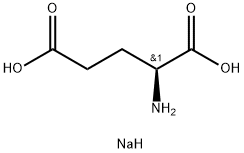Structural Formula

| Name | L-(+)Sodiumglutamate |
| Synonyms | L-Glutamicacidmonosodiumsaltmonohydrate, L-2-Aminopentanedioicacid, MSG, SodiumL-glutamate; L-(+)Sodiumglutamat; L-GlutamicChemicalbookacidmono; ;vetsin;zest |
| CAS No. | 142-47-2 |
| Molecular Formula | C5H10NNaO4 |
| Molecular Weight | 171.13 |
| EINECS No. | 205-538-1 |
| Melting point | 232°C |
| Specific rotation | 20-3.5°(10%solnin5°BéHCl); D20+25.16°(10gMSG/100ml2NHCl) |
| Density | d20(saturatedwatersoln):1.620FEMA2756|MONOSODIUMGLUTAMATE |
| Refractive index | 25°(C=10Chemicalbook,2mol/LHCl) |
| Solubility | Soluble in water sparinglysolubleinethanol(95%). |
| shape | powder |
Sodium glutamate is the main component of monosodium glutamate, a food flavoring agent. It is a sodium glutamate salt formed by sodium ions and glutamate ions. It is a colorless and odorless crystal at room temperature. It disintegrates and melts at 232°C and is easily soluble. In water (solubility: 74g/100ml). The appearance of monosodium glutamate has a history of more than 100 years. In 1866, Ritthausen hydrolyzed wheat bran with sulfuric acid to obtain acidic amino acids. In 1908, Dr. Kikunae Ikeda used kelp to separate the delicious ingredients and proved that the delicious ingredients were sodium glutamic acid, thus producing chemical seasonings and putting them on the market. At present, in foreign countries, sugar and honey are used as raw materials to produce monosodium glutamate, while in our country, food crops such as corn or rice are used to produce monosodium glutamate. For quite a long time in the past, whether MSG is beneficial or harmful to health has always been the focus of debate. Eating MSG within the normal range will not cause any damage to health, but excessive consumption will cause some people, especially Westerners, to experience headaches, flushing, sweating, facial compression or swelling, numbness in the mouth or around the mouth, Burning sensation in the stomach and chest pain and other poisoning symptoms, after poisoning, 50 mg of vitamin B6 can be taken orally every day to relieve symptoms. It should be used in moderation in daily life, and the daily consumption should not exceed 20 grams per person. In addition, when frying vegetables, you should wait until they are out of the pan before adding MSG. Because sodium glutamate will form coked sodium glutamate at a temperature of 120°C, coked sodium glutamate not only has very low umami taste, but also has certain toxicity and is a carcinogen. When cooking, the oil temperature is generally between 150°C and 200°C, which will turn monosodium glutamate into toxic coked sodium glutamate. Therefore, for the cooking of “semi-finished” side dishes with MSG, steaming and boiling should be appropriate.

